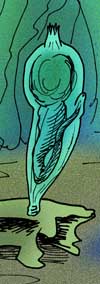| Revision as of 19:25, 4 July 2023 editPlantdrew (talk | contribs)Autopatrolled, Extended confirmed users, New page reviewers645,951 edits taxobox cleanup← Previous edit | Revision as of 12:04, 10 July 2023 edit undoSmith609 (talk | contribs)Administrators38,070 edits Cheungkungella misspellingNext edit → | ||
| Line 23: | Line 23: | ||
| pages = 47-51 | pages = 47-51 | ||
| }} | }} | ||
| </ref> is a ], and thus a member of the deuterostome total group. | </ref> (sometimes misspelt Cheungkungella)<ref>{{Cite journal | doi =10.1098/rspb.2009.0646}}</ref>is a ], and thus a member of the deuterostome total group. | ||
| It is known from the ] ] ] deposits of ], and was initially compared to the tunicates.<ref name="Shu24 May 2001">{{Cite journal | doi = 10.1038/35078069| last1 = Shu | first1 = X. L. | last2 = Chen | first2 = D. G. | pmid = 11373678 | last3 = Han | first3 = X. -L. | last4 = Zhang | first4 = X. -L. | title =An Early Cambrian tunicate from China| journal = Nature | volume = 411 | pages = 472–473 | date = 24 May 2001 | issue=6836}}</ref> It was originally described as a tunicate, though, this identification has been questioned, especially with the discovery of another Chengjiang tunicate, '']''. It has most recently been interpreted as a ] related to '']'', '']'' and '']''.<ref> Caron & Conway Morris 2010, Plos one</ref><ref>Li et al. 2023, Current Biology</ref> | It is known from the ] ] ] deposits of ], and was initially compared to the tunicates.<ref name="Shu24 May 2001">{{Cite journal | doi = 10.1038/35078069| last1 = Shu | first1 = X. L. | last2 = Chen | first2 = D. G. | pmid = 11373678 | last3 = Han | first3 = X. -L. | last4 = Zhang | first4 = X. -L. | title =An Early Cambrian tunicate from China| journal = Nature | volume = 411 | pages = 472–473 | date = 24 May 2001 | issue=6836}}</ref> It was originally described as a tunicate, though, this identification has been questioned, especially with the discovery of another Chengjiang tunicate, '']''. It has most recently been interpreted as a ] related to '']'', '']'' and '']''.<ref> Caron & Conway Morris 2010, Plos one</ref><ref>Li et al. 2023, Current Biology</ref> | ||
Revision as of 12:04, 10 July 2023
Genus of sea squirts
| Phlogites Temporal range: Chengjiang PreꞒ Ꞓ O S D C P T J K Pg N ↓ | |
|---|---|

| |
| Reconstruction of Phlogites | |
| Scientific classification | |
| Domain: | Eukaryota |
| Kingdom: | Animalia |
| Superphylum: | Deuterostomia |
| Stem group: | Ambulacraria |
| Clade: | †Cambroernida |
| Genus: | †Phlogites |
| Species: | †P. longus |
| Binomial name | |
| †Phlogites longus | |
| Synonyms | |
| |
Phlogites, a senior synonym of Cheungkongella ancestralis, (sometimes misspelt Cheungkungella)is a cambroernid, and thus a member of the deuterostome total group. It is known from the Lower Cambrian Haikou Chengjiang deposits of China, and was initially compared to the tunicates. It was originally described as a tunicate, though, this identification has been questioned, especially with the discovery of another Chengjiang tunicate, Shankouclava. It has most recently been interpreted as a cambroernid related to Eldonia, Rotadiscus and Herpetogaster.
References
- Hou, Xian-Guang; Bergström, Jan; Ma, Xiao-Ya; Jie, Z (2006). "The Lower Cambrian Phlogites Luo & Hu Re-Considered". GFF. 128: 47–51.
{{cite journal}}: CS1 maint: multiple names: authors list (link) - . doi:10.1098/rspb.2009.0646.
{{cite journal}}: Cite journal requires|journal=(help); Missing or empty|title=(help) - Shu, X. L.; Chen, D. G.; Han, X. -L.; Zhang, X. -L. (24 May 2001). "An Early Cambrian tunicate from China". Nature. 411 (6836): 472–473. doi:10.1038/35078069. PMID 11373678.
- Caron & Conway Morris 2010, Plos one
- Li et al. 2023, Current Biology
| Taxon identifiers | |
|---|---|
| Cheungkongella | |
This tunicate-related article is a stub. You can help Misplaced Pages by expanding it. |
This article related to a Cambrian animal is a stub. You can help Misplaced Pages by expanding it. |